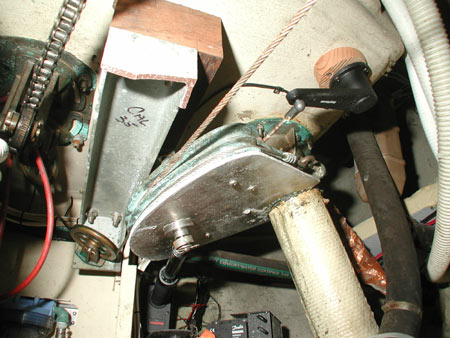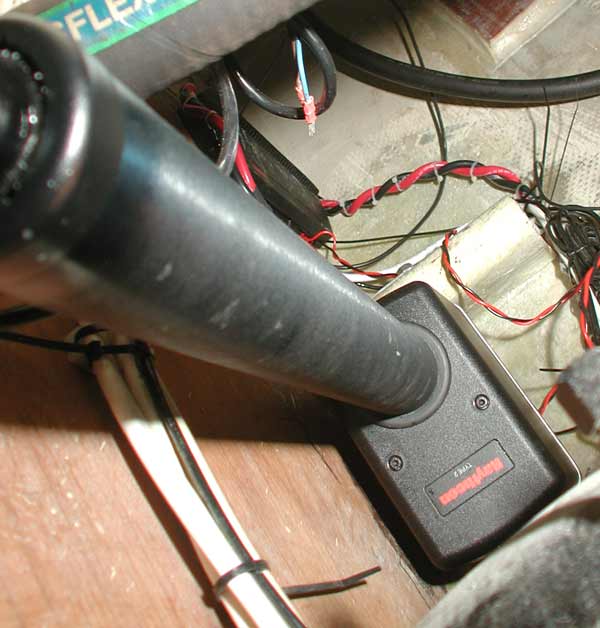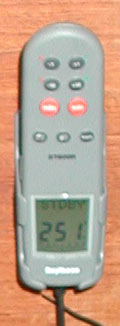| Autopilot:
Ray Marine Component System |
|||
| Botany Bay has gone through
several generations of autopilot systems over the years. Apparently
Botany Bay was delivered with a large below decks autopilot when built
in 1973. The system drove a sprocket integral with the binnacle base to
move the chain portion of the cable and quadrant steering system. I spent several years trying to make this system work reliably and eventually removed it completely and transitioned to an Autohelm ST4000 Wheel system. This system worked well for coastal passages, especially as a backup for the self steering vane. However, the during the Norfolk to the Abacos passage of 9 days it became apparent that it was not up to long distance passages. It is possible to help it along by pouring a cup of hot water into the gear mechanism twice a day to clear the salt crystals. The third autopilot installed on Botany Bay was an ST1000+ linear drive autopilot connected to the Monitor self steering vane. I used this system successfully between Redondo Beach and Catalina Island under moderate conditions. However, significant changes in standing helm can overwhelm the ability of the self steering vane to correct and have unpredictable results. This system continues to provide a backup for the below decks autopilot currently installed and in fact steered Botany Bay under nasty conditions coming up the backside of the Hawaiian Islands going into Honolulu for repairs. The current primary autopilot on Botany Bay is a Ray Marine component
system autopilot comprised of the following components: A word is in order about the choices between self steering vanes and autopilots (especially large, below deck mounted, fast autopilots). The Ray Marine component system with Gyro+ Yaw Damping (or the new Type 150G or 400G Course Computers with built in Gyro+) appear to do as good a job of steering as the Monitor Wind Vane (which is saying a lot, the Monitor wind vane can handle just about anything I can throw at it!) and the autopilot has the benefit of responding well to radical changes in weather helm (for example during a sail change or setting a spinnaker). However, there are two significant reasons to consider the self steering vane AND the below decks autopilot. The first is power consumption. I deliberately choose to run the autopilot exclusively for the downwind run from Hawaii to Kwajalein to examine this issue and test the replacement drive motor installed in Hawaii. I found that under moderate conditions the system consumed approximately 70Amp Hours/Day. This was measured using the secondary shunt on the Link 2000R energy monitor system. During rough conditions with the autopilot running at response level 3 (only level which uses the Gyro+ for this model) the consumption can easily be twice that. The second is redundancy. While I now have about 7000 open ocean miles on the installed Type 2 Long linear drive I did experience a failure of the first drive unit installed on Botany Bay. I was only using the autopilot at that time during sail changes and it failed with less than 10 hours of use. The technician in Hawaii and I examined the unit and found that the brushes had failed to seat correctly on the commutator and had put carbon dust everywhere. I had determined at sea that there was a position where the drive motor had infinite resistance and thus deduced that either the commutator was fouled or that a motor winding had failed as an open circuit. The fouled commutator was the cause and if it had not been for warrantee issues I could have easily cleaned it up with a point file and some care. If a drive motor had not been available in Hawaii I would have continued onward to Kwajalein and attempted the repair at sea and I feel it would have been successful. I now carry a spare drive motor (~$100US) and a spare gear cluster (~$75US) for the Type 2 Long drive unit there is an additional drive belt which is a Gates PowerGrip GT part number 3MR300-12-7-358DS which connects the drive motor to the gear cluster. For the passage back from Kwajalein to Los Angeles I also carried a spare drive unit borrowed from a friend at Kwajalein (Thanks to Paul Mosely!) and mailed back to him. Thus, the choices I see are as follows: Redundancy is a must, either 1) a large below decks autopilot AND a self steering vane or 2) a pair of identical autopilots (or very similar, i.e. interchangeable components for some or all of the systems) and the ability to switch out components easily. For Botany Bay the current fallback plan looks like this (assuming
you need the autopilot and not the vane): Note that when the main autopilot fails the quick fail over is the
ST1000+ driving the Monitor Self Steering Vane until the main autopilot
is back online. The idea would be that I could swap to either the primary or secondary core pack/linear drive chain buy connecting the SeaTalk bus to the appropriate core pack and engaging the pilot. If the failure was then diagnosed as a linear drive failure then the connection between the core packs and the linear drives could be swapped with a switch and the primary (preferred) core pack used with the backup linear drive. In a similar way there would be redundant rudder angle transducers and flux gate compasses which could be swapped between the two systems at the flip of a switch. These redundant systems provide the ability to quickly diagnose the failed component, have the system functional quickly, and know which replacement parts are required to bring the system back to full redundancy. Additionally this type of online redundancy reduces the need to carry spares which are never tested. Now, back to the issue of which is best? This depends if your vessel can handle the 70Amp Hours/Day (or twice that for a hydraulic unit) all the time and you don't mind the minor noise of the electronic drive unit then it is moving. This means that the electrical system redundancy is at least as important as the autopilot system redundancy. The self steering vane will continue to work with no power when following the wind and with less than 0.5 amps of current on average when using the small ST1000+ linear drive to command it. An aside: Having sailed Alegria (a Northwind 43) both directions between Los Angeles and San Francisco I can honestly say the new 400G series core pack (and I would assume the similar 150G series core pack) perform even better than the older Type 300 Core pack with an external Gyro+ unit! Additionally the "autolearn" mode allows the calibrations which normally take hours to get right to be done at the push of a button! On a very calm day you simply head the vessel into the wind and waves, trigger the "autolearn" mode. The autopilot will ask if you have sufficient sea room and then take the vessel through a series maneuvers (about +/- 45 degrees) while motoring which will calibrate the pilot. The performance of the pilot after calibration was exactly what I would expect it to be and no further calibrations were necessary! |
Here is a photo showing the installation of the Raymarine Type 2Long Linear Drive as well as the rudder angle reference transducer. Of specific interest is that the mounting point for the linear drive where it attaches to the hull is in the same plane as the quadrant. This ensures that the linear drive force is always perpendicular to the rudder shaft ensuring no loss of force or binding.
The connection of the autopilot to the vessel must be very strong. The type 2Long linear drive can easily generate some 1200lbs of force and the load can be cyclic which tends to break things. To install the linear drive I glassed a thick piece of plywood to the hull and a bulkhead to make a very firm mount. I have seen no indication that it is moving. This is the remote for the autopilot. The ability to carry it around and adjust the autopilot from anywhere on the boat is really useful.
|
||


